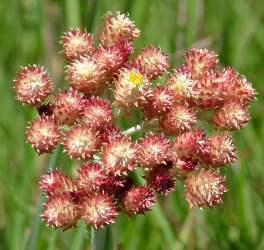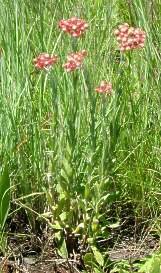Helichrysum appendiculatum
Helichrysum appendiculatum (L.f.) Less.
Family: Asteraceae
Common names: sheep's ears everlasting (Eng.); skaapoorbossie (Afr.); senkotoana (South Sotho); ibode, indlebeyemvu (Zulu)
Introduction
Strong pink and cream flowerheads and woolly leaves make Helichrysum appendiculatum a striking plant that would enhance any garden. Not yet in cultivation, it presents a challenge to growers of indigenous flora.

Description
Description
This is a perennial herb with a thick woody rootstock and one or several flowering stems, up to 550 mm tall, and closely leafy throughout, grey-woolly. The basal leaves are spreading, elliptic-oblong, and the upper leaves are woolly and smaller. The inflorescence is compact to spreading in terminal clusters, with flowerheads 7-15 mm long. The involucral bracts (surrounding the flowerheads) are dull creamy white or yellowish, sometimes pink-tipped, with tips short to long-pointed, sometimes recurved. The fruit is an achene (small dry fruit) crowned by a row of pappus hairs. Flowering occurs mainly between December and February, but as early as August and as late as April.

Conservation Status
Status
This plant is not threatened: the preliminary assessment in the Red Data List is Least Concern (LC).
Distribution and habitat
Distribution description
Helichrysum appendiculatum occurs in grasslands from Swellendam in the southern Western Cape eastwards and north-eastwards across the Cape mountains to the Eastern Cape, KwaZulu-Natal, Free State around Bethlehem and Harrismith, nearby Leribe in Lesotho, Swaziland, and the eastern highlands of the Limpopo province as far north as Modjadjiskloof (formerly known as Duiwelskloof). It is widespread in KwaZulu-Natal from near sea level to around 2100 m.
Derivation of name and historical aspects
History
The genus name Helichrysum is derived from the Greek word helios, meaning sun, and chrysos, meaning gold, and refers to the colourful flowerheads of many species in this genus. The species name appendiculatum is Latin, meaning 'with appendages', referring to the upper leaves of the species.
Dried flowers of the genus Helichrysum are said to last forever, hence they are also referred to as everlastings, immortals or sewejaartjies (seven years).
There are about 600 species world-wide, and more than 240 occur in southern Africa.

Ecology
Ecology
Because of the pappus on the achene or fruit, dispersal is achieved by wind. Insects are known to pollinate Helichrysum appendiculatum.
Uses
Use
Many species of this genus are widely used medicinally in both African and European traditions. A European medical record states that the researchers have found that Helichrysum oils are a more effective anti-inflammatory than German chamomile, have more tissue regenerating properties than lavender, and are more cicatrisant (helping the formation of scar tissue) than frankincense.
The leaves of Helichrysum appendiculatum are a Xhosa remedy for chest troubles, and they are sometimes eaten raw for this purpose. The plant is also used by traditional healers for smallpox, and is said to be antihelminthic (preventing worm infestation).
The white, woolly lower surface of the leaf is stripped to make fringes and body ornaments.
Helichrysums are also used for decoration. They have bright yellow, dull gold, pink, or silvery white flowers which are dried and used in flower pictures and for other purposes such as flower arrangements.

Growing Helichrysum appendiculatum
Grow
Helichrysum appendiculatum is easy to grow but should not be over-watered. It likes well-drained soil mixed with sand and compost, and requires a warm sunny place. Propagation is by stem cuttings in late summer, or by division of the roots in spring. H. appendiculatum also grows from seed (preferably sown in spring).
References
- Eliovson, S.1980. Wild flowers of southern Africa : how to grow and identify them, edn 6. Macmillan, Johannesburg.
- Fabian, A. & Germishuizen, G. 1997. Wild flowers of northern South Africa. Fernwood Press, Vlaeberg, Cape Town.
- Hilliard, O.M. 1977. Compositae in Natal. University of Natal Press, Pietermaritzburg.
- Hilliard, O.M. 1983. Asteraceae. Inuleae, Gnaphaliinae (first part). Flora of southern Africa 33, part 7, fascicle 2. Botanical Research Institute, Pretoria.
- Pooley, E. 2003. Mountain flowers. Field guide to the flora of the Drakensberg and Lesotho. Flora Publications Trust, Durban.
- Watt, J.M. & Breyer-Brandwyk, M.G. 1962. The medicinal and poisonous plants of southern and eastern Africa, edn 2. Livingstone, Edinburgh and London.
Credits
Julia Mnengwane
National Herbarium, Pretoria
October 2005
Plant Attributes:
Plant Type: Perennial
SA Distribution: Eastern Cape, Free State, KwaZulu-Natal, Limpopo, Mpumalanga, Western Cape
Soil type: Sandy, Loam
Flowering season: Spring, Early Summer, Late Summer
PH: Acid
Flower colour: White, Pink, Cream
Aspect:
Gardening skill: Easy
Special Features:
Horticultural zones









Rate this article
Article well written and informative
Rate this plant
Is this an interesting plant?
Login to add your Comment
Back to topNot registered yet? Click here to register.